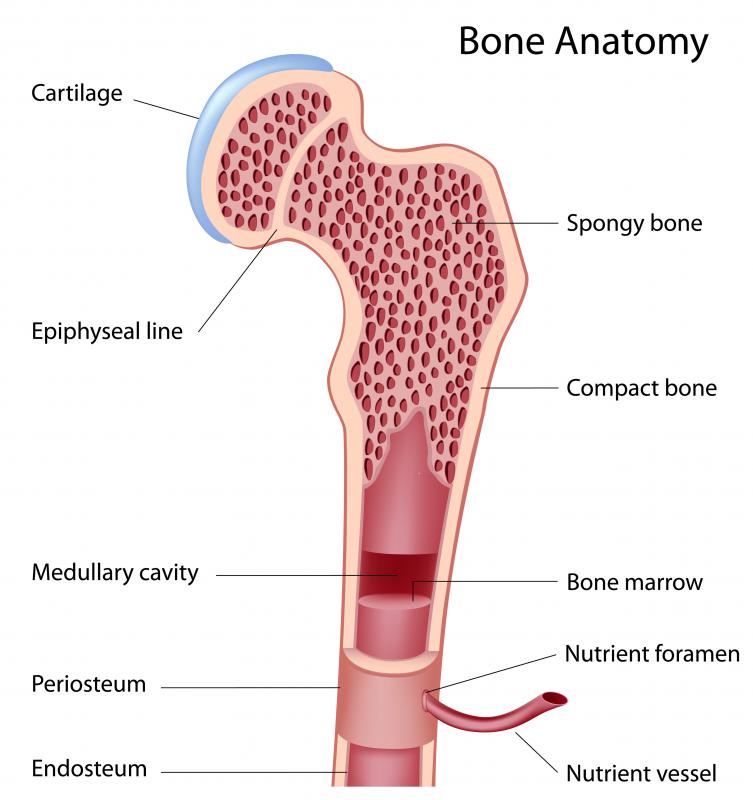At WiseGEEK, we're committed to delivering accurate, trustworthy information. Our expert-authored content is rigorously fact-checked and sourced from credible authorities. Discover how we uphold the highest standards in providing you with reliable knowledge.
What are the Different Skeletal Functions?
The skeleton serves a number of different functions, with many scientists identifying six distinct skeletal functions which are especially important. Animals with skeletons rely on their skeletons for support, protection, bodily movement, production of blood cells, mineral storage, and points of attachment for muscles and tendons. As one can see by examining the skeletons of different animals, the skeleton can be arranged in a number of different ways to create animals of different shapes and to fulfill specific needs. Many animals, for example, need a tail for balance and have a series of articulated bones to support the structure of the tail.
Support is one of the most obvious skeletal functions; to understand how support works, imagine a person without a skeleton. The skeleton creates a rigid framework which determines the shape of the body and helps the body hold its shape. This can sometimes be limiting; animals can only compact as much as their skeletons will allow. Protection is another key skeletal function, with the skeleton protecting the vulnerable brain and lungs inside casings of bone which isolate these organs from impact.

Bodily movement is actually a function of the skeleton and the muscles together, sometimes known as the musculoskeletal system. This system allows people to engage in a variety of movements, from taking huge strides while running to manipulating the fingers in the fine movements needed to play a musical instrument. Another of the skeletal functions, production of blood cells, takes place in the bone marrow inside the skeleton, where stem cells which can differentiate into different types of blood cells as needed are made.

The skeleton also stores minerals for the body. If someone experiences deprivation, she or he can draw on the skeleton for minerals and energy, up to a certain point. The skeleton constantly replenishes its supply of minerals as people consume minerals, ensuring that it has a buffer of stored minerals available. Finally, another of the skeletal functions is as a point of attachment for muscles and tendons. The musculoskeletal system's interconnected nature uses the bones to support the muscles, and the muscles to control the movement of the bones.

As can be seen from this brief overview of the skeletal functions, the skeleton is a busy part of the body. Problems which can impede skeletal function include congenital conditions which interfere with skeletal growth, cancers of the bone and bone marrow, broken bones, and diseases which interfere with the function or strength of muscles and tendons.
AS FEATURED ON:
AS FEATURED ON:















Discussion Comments
@MrsWinslow - Breastfeeding slows down the regrowth of your bones after pregnancy, but does not prevent it. Yes, your body will use calcium to make milk for baby. In addition, estrogen levels are low during breastfeeding, and that also keeps calcium off your bones.
But according to the NIH (National Institutes of Health - government agency), within about six months after weaning your baby, you will have regained any lost bone density.
Breastfeeding advocates actually claim that breastfeeding *protects against osteoporosis in later life. I'm not sure how good their evidence is, but they say that when you regain bone density after breastfeeding, it often comes back even denser than before. So don't let that worry you - breastfeeding is good for mom (in most circumstances) as well as baby!
The idea of the skeletal system as a storehouse for minerals is interesting; I never quite thought of it that way, but I guess I knew that women used it like that. We take out calcium and use it to grow babies!
My question is about breastfeeding. Does that keep your body from rebuilding your bones after pregnancy? It seems like you would need to dump all your calcium into your milk for the baby and then not have any left for yourself. What about your bones?
Post your comments